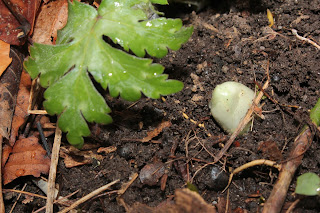Yesterday I went out in search of Ruffed Grouse and spring plants. My first stop was Parkhill Conservation Area, in northwest Middlesex. This is a well known spot for both of the things I was seeking. Last June, I visited Parkhill CA in search of plants, and flushed a bird in the bushed I was 99% sure was a grouse, but since it would be a county bird, I obviously wanted to be sure.
I arrived at the CA shortly after 7:30 (I checked out the reservoir first, but there wasn't any waterfowl). It was about 5 degrees out, so not super warm, but pleasant. It wasn't long before the Western Chorus Frogs and Spring Peepers started calling.
As I was walking through the woods, I found a single plant of what I believe is Spreading Sedge (Carex laxiculmis var. laxiculmis). The glaucous leaves make it var. laxiculmis.
I continued along the top of the ravine. Plantain-leaved Sedge (C. plantaginea) was common.
 |
| The short red bracts are evident here! |
Wide Leek (Allium tricoccum var. tricoccum) was another numerous species. I might cover this species in more depth in a future post.
The first of the "Hey, that's early" moments came with this Early Meadow-Rue (Thalictrum dioicum).
Finally, I managed to hear a Ruffed Grouse drumming. New county bird! I heard it a couple times again later. I could now just focus on the plants :)
The first hepatica (Hepatica acutiloba) plant I looked at was this "four-leaved" oddity. Perhaps it was a good luck omen?
Lots of the normal looking plants as well, including some in flower.
Eventually, I decided to descend down into the ravine and head back. Seems I picked the right spot to go down, because I ended up coming across a big patch of Carey's Sedge (C. careyana)! This was one of my most wanted plants, and I was keeping a sharp eye out for it on this day. It is similar to Plantain-leaved Sedge, but the leaves have a more "unwrinkled" appearance. I didn't end up getting any good pictures of it, but the bract (basically a specialized leaf) is much longer and is green on Carey's Sedge, whereas it is short and red on Plantain-leaved. Carey's Sedge is ranked S2 in Ontario, meaning it is very limited in distribution, but it is known to occur in this area.
 |
| You can sort of see the green bracts here... |
An assortment of other spring plants, several of which I don't normally see until mid-April!
 |
| Early Blue Cohosh (Caulophyllum giganteum) |
 |
| Bloodroot (Sanguinaria canadensis) |
 |
| Trout lily (Erythronium sp.) |
 |
| Cut-leaved Toothwort (Cardamine concatenata) |
 |
| Broad-leaf Waterleaf (Hydrophyllum canadense) |
 |
| Mayapple (Podophyllum peltatum) |
 |
| probable Twinleaf (Jeffersonia diphylla) |
 |
| Bright Silkmoss |
 |
| Dwarf Anomodon Moss (Anomodon minor) |
I finished up at Parkhill, and the decided to stop into Coldstream CA on my way home. I had just under an hour to explore it.
There was a large naturalized population of Japanese Pachysandra (Pachysandra terminalis) along the river. This is a non-native species. I am not sure how invasive it is, but it is one to be aware of.
I added another species of toothwort to the day list, Two-leaved Toothwort (Cardamine diphylla).
False Mermaidweed (Floerkea proserpinacoides) was just one of the species found in the floodplains.
As I was on my way out, I spied this sedge, which stopped me dead in my tracks. It looked like Carey's Sedge! I am not sure if it is known to occur in this location, although I do know it is known to be found further down the Sydenham River. Although I am pretty sure it is indeed this species, I'll have to go back to confirm it once it grows a bit more.
What an enjoyable few hours! I even managed to get a few plant lifers. I'm sure I'll be back out there soon...

















Hi Quinten! Sounds like you had a fun, successful day! Spring has sprung! 😉
ReplyDelete